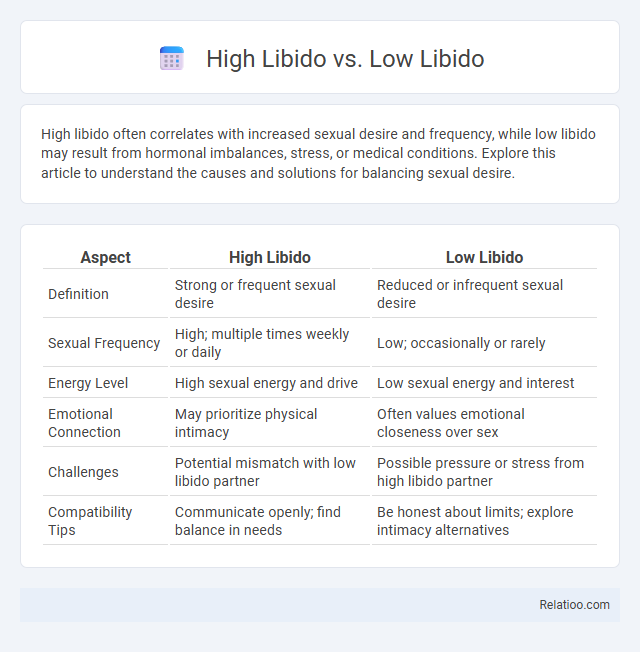High libido often correlates with increased sexual desire and frequency, while low libido may result from hormonal imbalances, stress, or medical conditions. Explore this article to understand the causes and solutions for balancing sexual desire.
Table of Comparison
| Aspect | High Libido | Low Libido |
|---|---|---|
| Definition | Strong or frequent sexual desire | Reduced or infrequent sexual desire |
| Sexual Frequency | High; multiple times weekly or daily | Low; occasionally or rarely |
| Energy Level | High sexual energy and drive | Low sexual energy and interest |
| Emotional Connection | May prioritize physical intimacy | Often values emotional closeness over sex |
| Challenges | Potential mismatch with low libido partner | Possible pressure or stress from high libido partner |
| Compatibility Tips | Communicate openly; find balance in needs | Be honest about limits; explore intimacy alternatives |
Understanding Libido: What Is It?
Libido refers to an individual's overall sexual drive or desire, influenced by biological, psychological, and social factors. High libido manifests as an increased frequency of sexual thoughts and desires, while low libido indicates a reduced interest in sexual activity, which can be caused by hormonal imbalances, stress, or medical conditions. Understanding libido requires recognizing its variability across individuals and life stages, emphasizing that fluctuations are normal and influenced by both internal and external factors.
Key Differences Between High and Low Libido
High libido is characterized by a strong sexual desire and frequent interest in sexual activity, often linked to elevated hormone levels like testosterone and psychological factors such as confidence and reduced stress. Low libido involves a decreased or absent sexual desire, commonly associated with hormonal imbalances, medication side effects, mental health issues like depression, or chronic illnesses. Understanding these differences helps tailor effective treatments, including hormone therapy, counseling, or lifestyle changes to restore sexual health.
Factors Affecting Libido Levels
Libido levels vary significantly between individuals due to a combination of biological, psychological, and environmental factors. Hormonal imbalances, stress, medication side effects, and relationship dynamics play crucial roles in determining whether you experience high libido, low libido, or a moderate level. Understanding these factors can help you identify strategies to balance your sexual desire for improved well-being.
Psychological Influences on Libido
Psychological influences on libido significantly impact sexual desire, with high libido often linked to positive mental health, reduced stress levels, and strong emotional connections. Low libido may result from anxiety, depression, or unresolved trauma, which disrupt hormonal balance and diminish sexual interest. Understanding these psychological factors is crucial for addressing variations in libido and promoting overall sexual well-being.
Hormonal and Biological Causes
Hormonal and biological causes significantly influence your libido, with high libido often linked to elevated levels of testosterone and dopamine that enhance sexual desire and arousal. Low libido typically results from imbalances or deficiencies in hormones such as testosterone, estrogen, or thyroid hormones, along with increased cortisol levels caused by stress, which can suppress sexual drive. Understanding these hormonal variations helps identify whether differences in libido stem from natural biological fluctuations or underlying health conditions affecting sexual function.
Impact of Lifestyle and Health on Sexual Drive
High libido often correlates with a balanced lifestyle that includes regular exercise, a nutritious diet, and adequate sleep, which enhance hormonal health and blood circulation. Low libido can result from chronic stress, poor diet, lack of physical activity, or underlying health conditions such as diabetes or hormonal imbalances. Your sexual drive fluctuates based on these lifestyle factors, making adjustments in daily habits crucial for maintaining a healthy libido.
Relationship Dynamics: Navigating Libido Mismatches
High libido and low libido represent varying sexual desires that can significantly impact relationship dynamics, often causing tension when partners have mismatched levels. Understanding and communicating your libido needs fosters emotional intimacy, helping couples navigate potential conflicts without resentment. Finding compromise through empathy and open dialogue strengthens the relationship despite differing sexual drives.
Myths and Misconceptions About Libido
Libido often faces myths such as the belief that a high libido always indicates better health or that low libido signals a serious problem. Your sexual desire varies widely among individuals and can be influenced by factors like stress, hormones, and relationships rather than just physical health alone. Understanding these misconceptions helps you approach libido as a dynamic aspect of well-being rather than a fixed or pathological state.
Strategies for Addressing Libido Concerns
High libido usually indicates increased sexual desire, which can enhance intimacy but may require communication to align with your partner's needs. Low libido often results from stress, hormonal imbalances, or medical conditions, and addressing these through therapy, lifestyle changes, or medical treatment can improve sexual health. Balanced libido involves understanding personal triggers and using targeted strategies like mindfulness, exercise, or counseling to maintain a satisfying sexual experience.
When to Seek Professional Help for Libido Issues
Persistent changes in libido, whether high or low, that impact daily functioning or relationships warrant consulting a healthcare professional. Medical evaluation can identify underlying causes such as hormonal imbalances, psychological factors, or medication side effects affecting sexual desire. Timely intervention through therapy, medication adjustments, or lifestyle changes enhances overall well-being and sexual health.

Infographic: High Libido vs Low Libido
 relatioo.com
relatioo.com